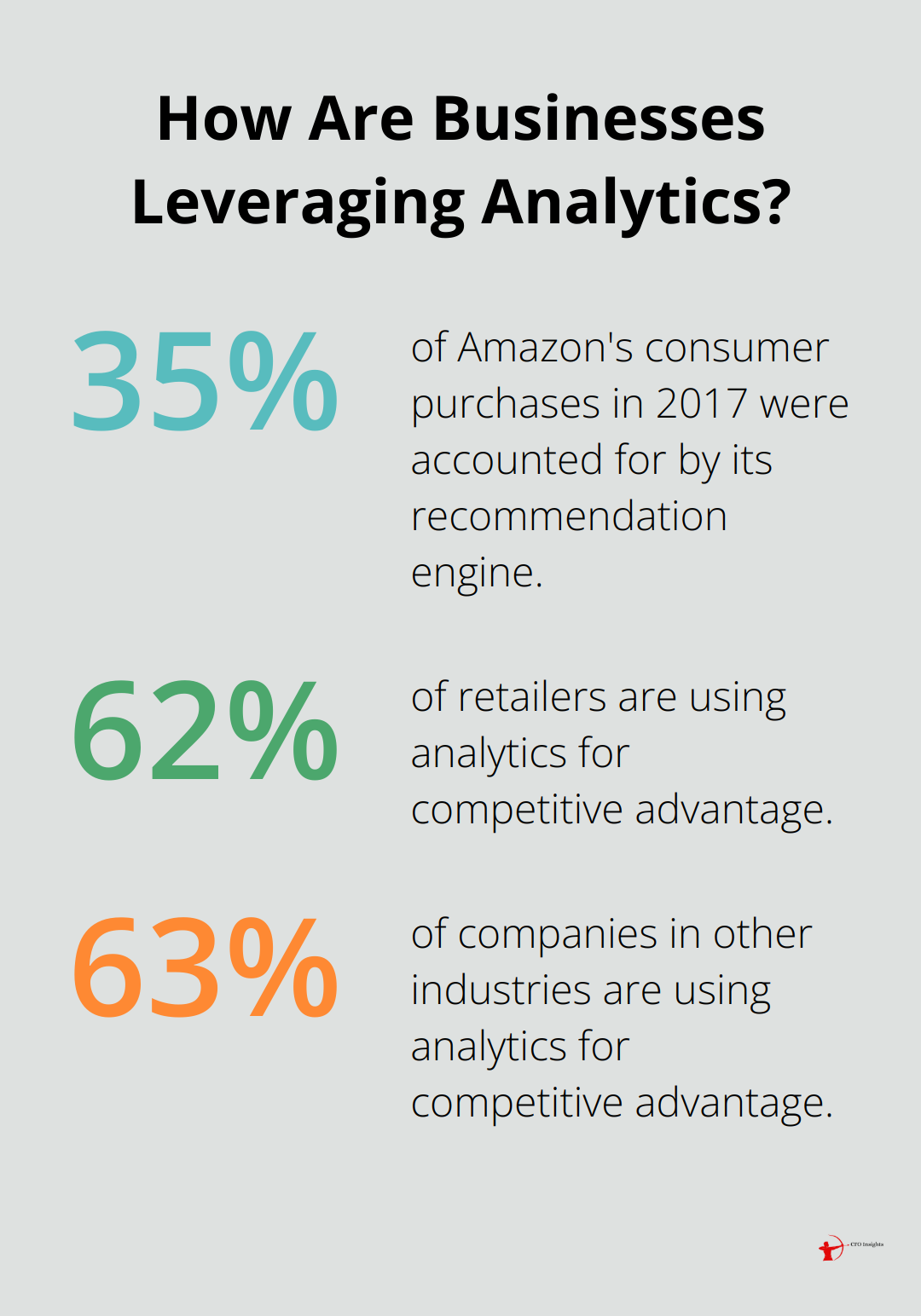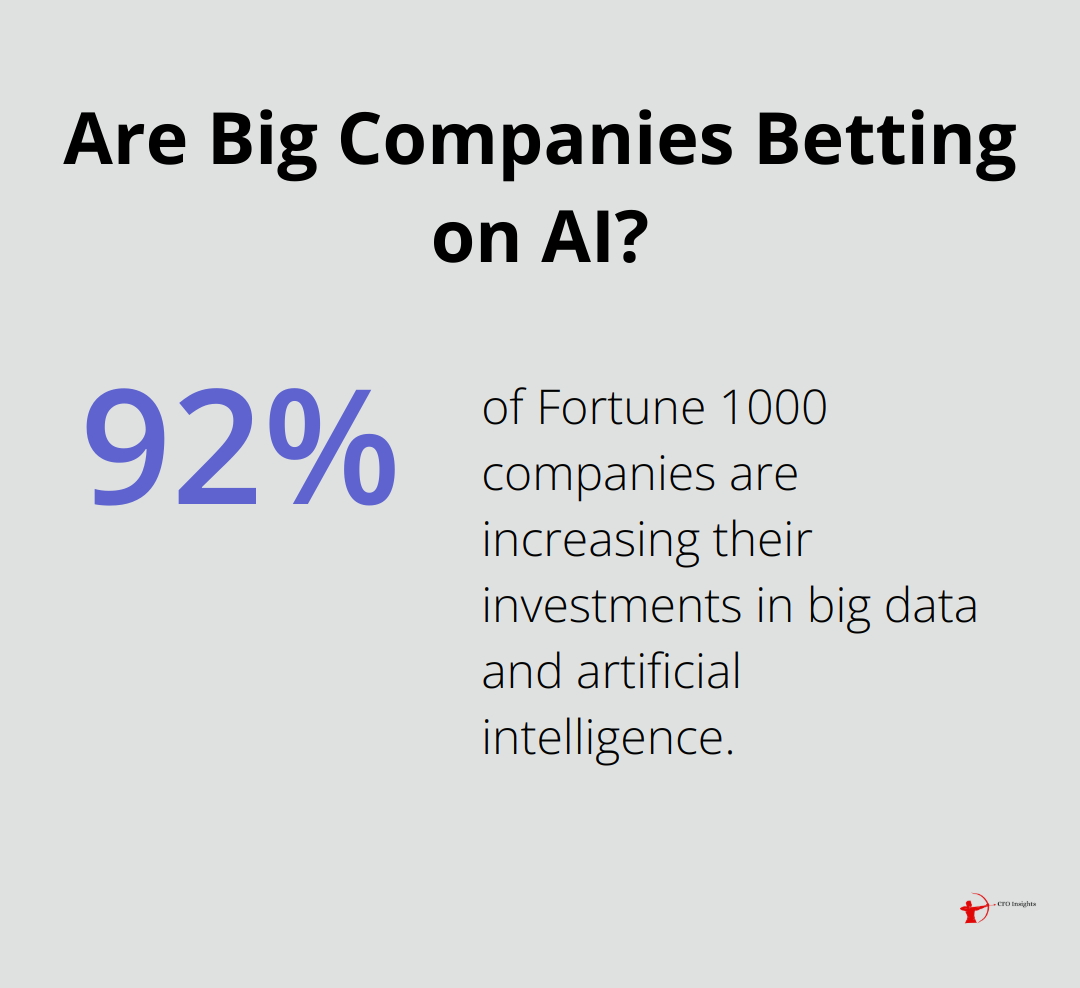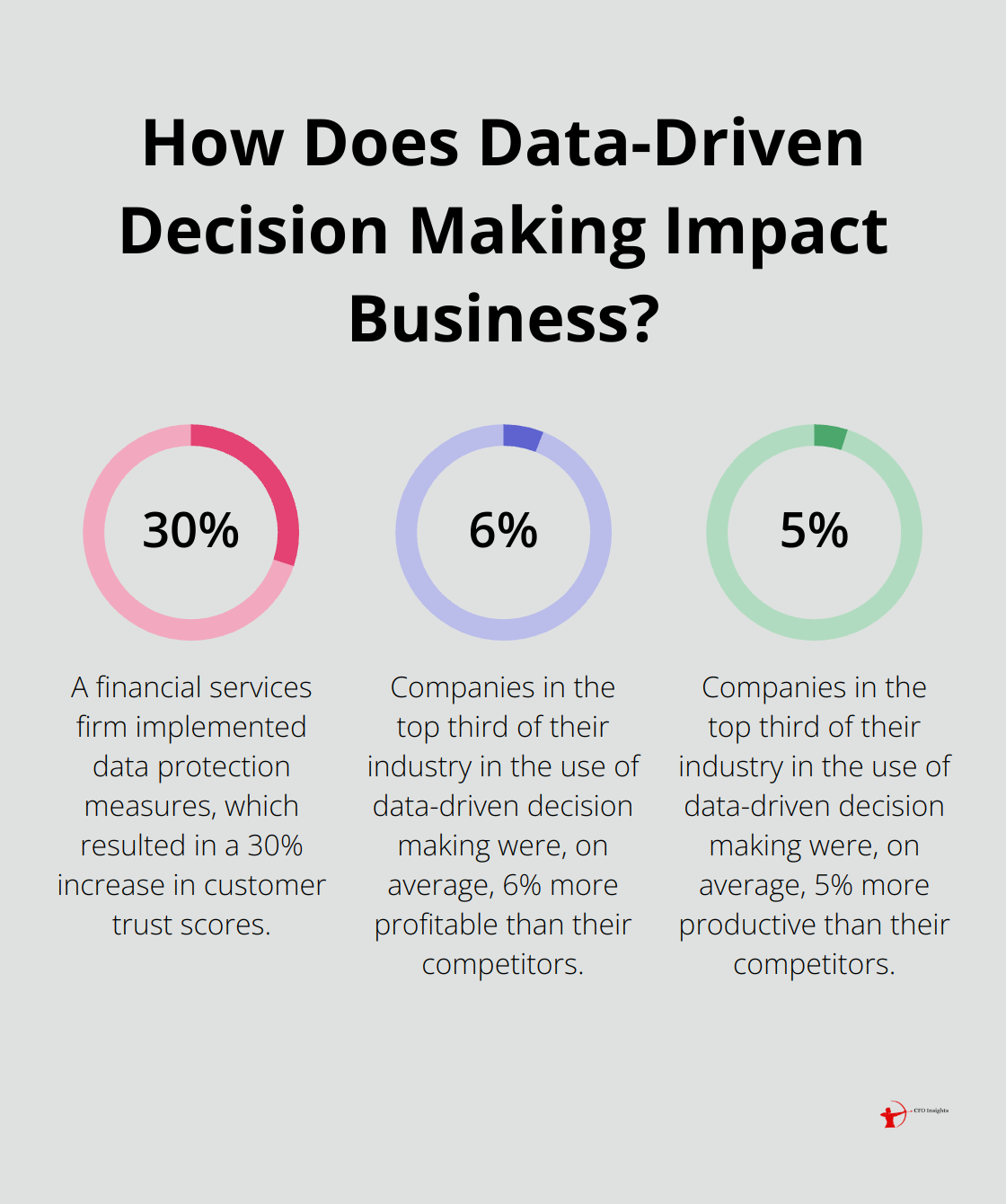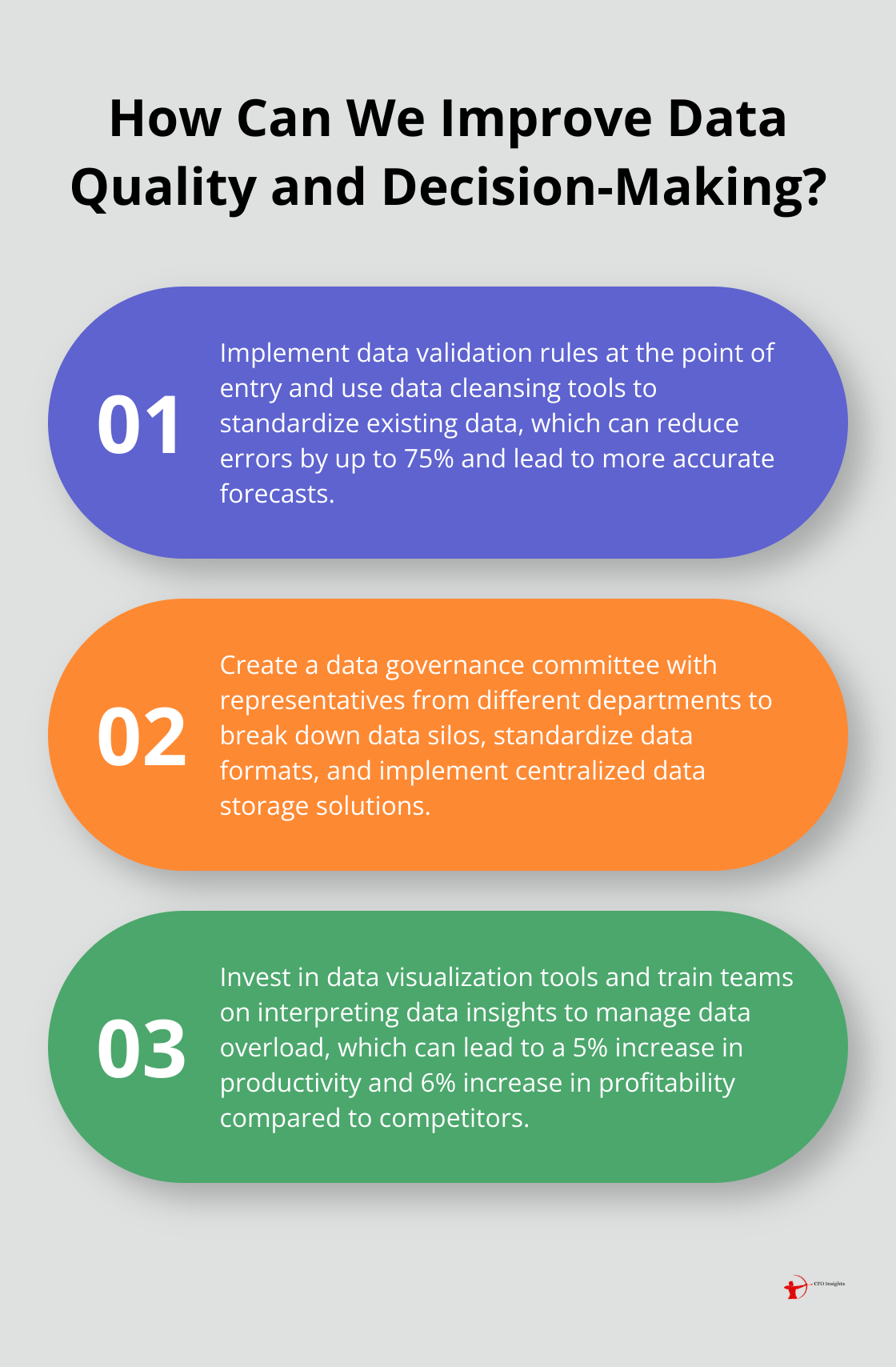In today’s fast-paced business world, data-driven decisions are the key to staying ahead of the competition. At CFO Insights, we’ve seen firsthand how companies that harness the power of data gain a significant edge over their rivals.
Data-driven decision-making allows organizations to make more accurate choices, respond quickly to market changes, and uncover hidden opportunities. This blog post will explore why embracing a data-centric approach is essential for your company’s success and how you can implement it effectively.
How Data Boosts Decision-Making
Data-driven decision-making transforms how businesses operate. Companies that leverage data effectively make better choices, respond faster to market shifts, and spot opportunities others miss.
Precision in Decision-Making
Data analysis improves decision accuracy significantly. Highly data-driven organizations are 3X more likely to report significant improvement in decision-making. This precision gives companies a competitive edge in today’s market.

Starbucks exemplifies this approach. The company uses location analytics to determine prime store locations. By analyzing demographics and traffic patterns, Starbucks has improved its site selection process, leading to more successful store openings.
Accelerated Decision Processes
Data-driven approaches speed up decision-making. With the right tools, businesses can process vast amounts of information quickly. Amazon’s recommendation engine (powered by data analytics) accounted for 35% of its consumer purchases in 2017, according to McKinsey. This rapid analysis allows for real-time adjustments to marketing strategies and inventory management.
Uncovering Hidden Patterns
Data analysis reveals trends that might otherwise go unnoticed. Google’s Project Oxygen analyzed over 10,000 performance reviews to identify traits of effective managers. This data-driven approach increased leadership favorability scores from 83% to 88%.
Retailers using analytics for competitive advantage have grown to 62%, with comparable findings in other industries at 63% (as reported by IBM). These insights allow businesses to stay ahead of market trends and consumer preferences.
Enhancing Customer Experience
Data-driven decisions lead to improved customer experiences. Companies can tailor their offerings to meet specific customer needs by analyzing customer behavior and preferences. For instance, The North Face uses consumer data through their app to provide personalized recommendations, enhancing user experience and increasing customer satisfaction.
Optimizing Operations
Data analytics helps businesses identify inefficiencies and optimize operations. This optimization can lead to significant cost savings and improved productivity.
Data-driven decision-making provides companies with a powerful toolkit to navigate complex business landscapes. The next section will explore how to implement these strategies effectively in your organization.
How to Build a Data-Driven Organization
Create a Data-First Mindset
The foundation of a data-driven organization is a culture that values and prioritizes data. This shift starts at the top. Leadership must champion the use of data in decision-making processes. Teams should back up their ideas with data, and data-driven initiatives should receive rewards.
A study by NewVantage Partners found that 92% of Fortune 1000 companies are increasing their investments in big data and artificial intelligence. This underscores the importance of fostering a data-centric culture across all levels of the organization.
Choose the Right Tools
Investing in the appropriate data analytics tools is essential. These tools should align with your specific business needs and goals. For instance, if your focus is on customer behavior, a robust Customer Relationship Management (CRM) system integrated with analytics capabilities might be your priority.

Google Analytics (a powerful, free tool for web analytics) can provide valuable insights into user behavior. For more advanced needs, platforms like Tableau or Power BI can help visualize complex data sets, making them more accessible to non-technical team members.
Prioritize Data Literacy
Data literacy is the ability to read, understand, create, and communicate data as information. It’s essential for everyone in your organization (not just data scientists or analysts).
Invest in training programs to improve data literacy across your workforce. This could include workshops on basic statistical concepts, data visualization techniques, or how to interpret common business metrics.
Companies that have successfully implemented data literacy programs report improved decision-making at all levels. Companies like Google, Adobe, Guardian, and Bloomberg have nurtured data-literacy training resources for their employees, which has even helped reduce costs.
Ensure Data Quality
The saying “garbage in, garbage out” holds especially true for data-driven decision-making. Implement processes to ensure data quality and integrity. This includes regular data audits, clear data governance policies, and investing in data cleaning tools.
A study by Gartner found that poor data quality costs organizations an average of $12.9 million per year. Prioritizing data quality not only improves decision-making but also saves money.
Break Down Data Silos
Data silos can severely hamper your data-driven efforts. Encourage cross-departmental collaboration and implement systems that allow for easy data sharing across the organization.
Cloud-based data warehouses can effectively centralize data from various sources. This allows for a more holistic view of your business operations and can lead to insights that might be missed when data is compartmentalized.
The journey to becoming a data-driven organization is ongoing and requires continuous refinement. As you implement these strategies, you’ll likely encounter challenges along the way. In the next section, we’ll address common obstacles and provide practical solutions to overcome them.
Adapt to Changing Regulations
Companies that proactively adapt to new regulations often gain a competitive edge. This is particularly true in the realm of data management and analytics, where regulations are constantly evolving. Stay informed about changes in data protection laws and industry-specific regulations to ensure your data-driven strategies remain compliant and effective.
Navigating Data Challenges
Ensuring Data Quality
Poor data quality can lead to misguided decisions. Poor data quality costs organizations at least $12.9 million annually on average, according to Gartner research from 2020. To address this:
- Implement data validation rules at the point of entry.
- Audit your data regularly for accuracy and completeness.
- Use data cleansing tools to standardize and correct existing data.
- Establish clear data governance policies and educate staff on their importance.

A mid-sized manufacturing company reduced data errors by 75% after implementing these measures, which led to more accurate inventory forecasts and reduced waste.
Balancing Data and Intuition
Data is crucial, but human intuition still plays a vital role. The key is to find the right balance. Here’s how:
- Use data to inform decisions, not dictate them.
- Question data that contradicts experience.
- Combine quantitative data with qualitative insights from customer feedback and employee observations.
A retail company increased sales by 15% by combining data on customer purchasing patterns with insights from in-store staff about customer preferences.
Addressing Privacy and Security Concerns
With increasing regulations like GDPR and CCPA, data privacy and security are more important than ever. To manage these concerns:
- Implement robust data encryption and access controls.
- Train staff regularly on data protection best practices.
- Conduct periodic security audits and penetration tests.
- Be transparent with customers about data usage and provide opt-out options.
A financial services firm implemented these measures, which resulted in a 30% increase in customer trust scores and zero data breaches in the following year.
Overcoming Data Silos
Data silos hinder cross-departmental collaboration while giving rise to inconsistent data quality and communication gaps. To break down these barriers:
- Promote cross-departmental collaboration.
- Implement centralized data storage solutions.
- Standardize data formats across the organization.
- Create a data governance committee with representatives from different departments.
Companies that successfully break down data silos often see improved efficiency and more comprehensive insights.
Managing Data Overload
The sheer volume of data available can be overwhelming. To manage this effectively:
- Define clear objectives for data collection and analysis.
- Prioritize data sources based on their relevance and reliability.
- Invest in data visualization tools to make insights more accessible.
- Train teams on how to interpret and act on data insights.
Companies in the top third of their industry in the use of data-driven decision making were, on average, 5% more productive and 6% more profitable than their competitors.
CFO Insights helps companies navigate these challenges, ensuring that data-driven decision-making becomes a competitive advantage rather than a stumbling block. By integrating sustainable finance into your strategy, you can further boost growth and drive positive environmental and social impact in your business.
Final Thoughts
Data-driven decisions have become essential for business success in today’s competitive landscape. Companies that leverage data gain a significant edge, improving efficiency, enhancing customer experiences, and driving innovation. As technology evolves, businesses must adapt their strategies, reassess data collection methods, and update analytics tools to stay ahead.

The future of data-driven organizations promises even more sophisticated analysis capabilities. Advancements in artificial intelligence and machine learning will enable more accurate predictions and deeper insights from vast amounts of data. However, successful organizations will strike the right balance between data insights and human expertise, using data to inform decisions while relying on experience to guide strategy.
CFO Insights understands the transformative power of data-driven decisions. Our fractional CFO services help organizations harness the full potential of their financial data, providing strategic insights to drive growth and optimize performance. Those who embrace this approach and adapt to new technologies will thrive in the data-driven future that lies ahead.




